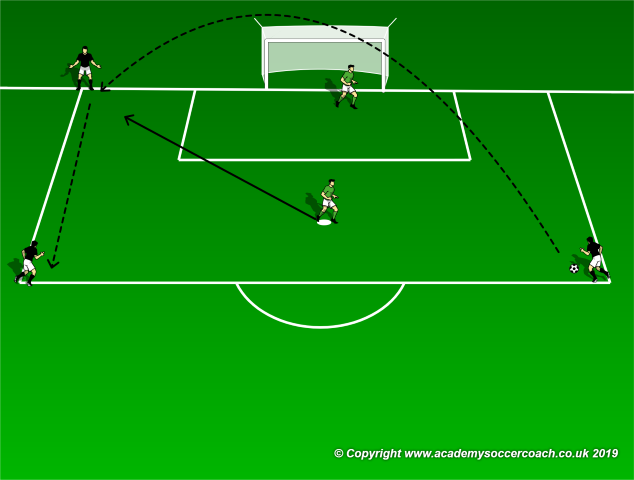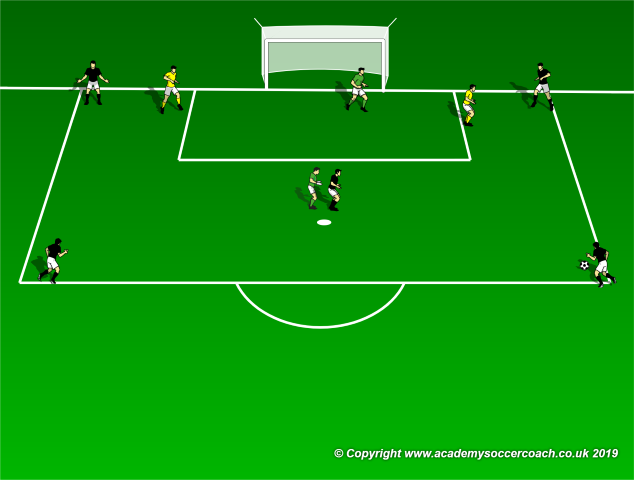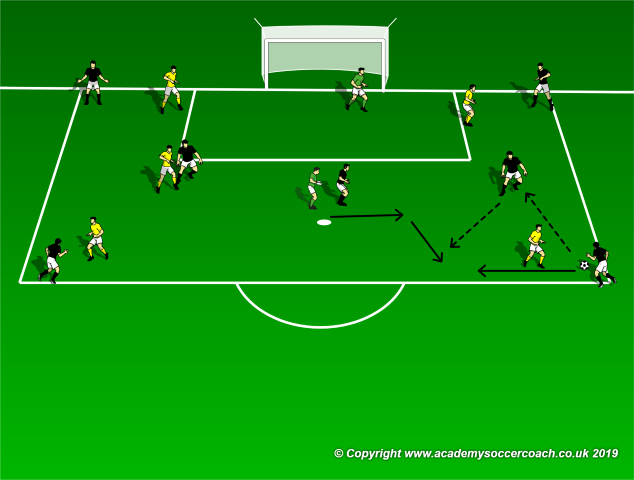By Mike Smith -
I see tons of keepers who are good on the line or even inside the keeper box, but then struggle coming out or reading balls which aren’t straight on target. I think this comfort on the line or right in front of goal is part of a keeper’s natural progression, but a keeper should feel comfortable commanding the entire penalty area. Something which I have found useful in teaching this is a drill involving a traditional keeper, who must stay inside the goalie box and then a “ roaming keeper” who can play inside the entire penalty area; here is how it works:
Set Up
As shown below, 3 attackers start inside the penalty area against 2 goal keepers. One goal keeper must stay inside the goalie box ( the 6 ) while the other must stay inside the penalty box ( the 18 ). The keeper inside the 18 is the “ roaming “ keeper and may not play inside the 6. Play starts with an attacker on the corner of the 18 making a long cross ( as shown ). Once the player on the end line receives the cross, they must play it to the remaining attacker before free play begins. The idea is for the roaming keeper to either catch the initial service if it is hit too low, or turn and be in a position to smother the final pass before free play can begin ( second diagram below ).


If the roaming keeper is not able to get the ball, they may defend the play as best they can, and are free to use their hands at any time.

Progression
As shown above, add 2 more attackers and 2 defenders. All players should set up as in the diagram, with the roaming keeper marking to force a pass to the far attacker at the top corner of the 18. Again, the roaming keeper is free to make a play on the initial service, which must be hit to the open player to start, but can then be hit anywhere as free play progresses. The roaming keeper can intercept balls with their hands at any time until the coach calls for the reset ( after 10 – 30 seconds ).
Final Progression
Finally, let 7 attackers face 7 defenders, 5 field players a traditional keeper and the roaming keeper. Play still starts from the corner and the first pass is made to the open attacker. As shown below, the roaming keeper should step immediately to cut off their mark and then anticipate the next pass. Once the defense recovers their shape, there should be ample opportunity for the roaming keeper to pick off balls with their hands. To keep play going, have the roaming keeper play any wins back to the traditional keeper to distribute wide to the top corners of the 18 for either a “score” to their player or the restart should the attacking side win the ball.

Coaching Points
The coach should rotate the keepers between the traditional and roaming roles. The idea is just to get the keepers comfortable anticipating balls and making plays under pressure in a “scrum”, without the fear of getting burnt. Obviously in a match the keeper will still spend most of their time on the line and in the goalie box, however, when they need to come out farther into the penalty area, this drill will help give them the confidence to do so. The coach should put a premium on the roaming keeper actually winning every attempt they make on the ball.
By Mike Smith
Currently the Head Coach for University Heights Academy Boys Soccer in Hopkinsville, KY , Mike is in his 14th year as a high school head coach with 23 years coaching experience overall and 34 year as a student and fan of the game. He holds a USSF D License.


